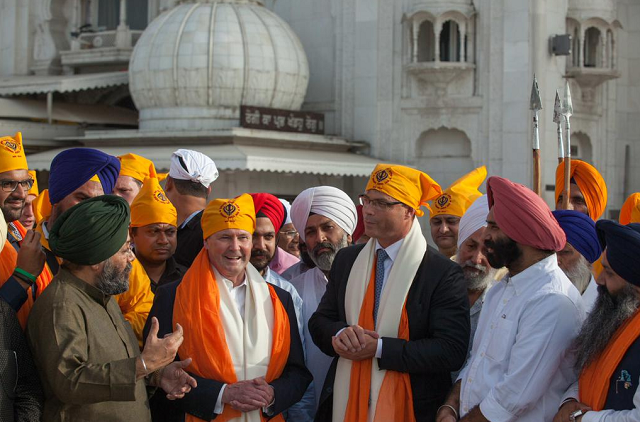
In the First World War, Indian and Australian servicemen fought together on the beaches of Gallipoli, in the deserts of Mesopotamia and the Middle East, and in the fields of France.
In the Second World War, our armed forces served alongside each other in the Mediterranean, Middle Eastern, North African, and Pacific theatres, most notably during the siege of Tobruk by Rommel’s Africa Corp, and the Burma campaign to defend India from falling to Japan.
This shared history, coupled with our shared democratic values and a strong interest in a secure Indo–Pacific region, provides us with a firm foundation upon which we can confidently pursue future engagement activities in support of our joint interests.
We both border the Indian Ocean and have a shared interest in the maintenance of freedom of navigation and trade. In fact, the world economy is fast becoming reliant upon Indian Ocean trade as its bulk cargo grows.
Australia recognises India’s critical role in supporting the security, stability and prosperity of the Indian Ocean region and the stability of a wider, rules‑based global order.
This is why Australia views India as a key strategic partner—and there is scope for us to cooperate further on broader global issues.
By 2030, the Indo–Pacific region is expected to account for 21 of the top 25 sea and air trade routes; around two thirds of global oil shipments and one third of the world’s bulk cargo movements. So improving security will be crucial to protecting our prosperity.
Australia strongly believes that ASEAN-centric multilateral frameworks have contributed to security and stability in the wider Indo–Pacific region by building degrees of trust and habits of cooperation.
Perhaps most significantly, our navies will conduct our first Bilateral Maritime Exercise—Exercise AUSINDEX—later this month. The Exercise will take place in the Indian Navy’s Eastern Fleet exercise area off the coast of Visakhapatnam.
The Exercise is a significant step forward in the bilateral defence relationship. It is a sign of growing naval cooperation between both nations. Australia will be sending an
ANZAC-class frigate (HMAS Arunta); an oiler (HMAS Sirius) a
Collins-class submarine (HMAS Sheean) and an AP3-C maritime surveillance aircraft. In total, Australia’s contribution will number around 400 personnel—with a similar contribution from India.
But the potential for greater cooperation between our Defence organisations is not confined to the naval sphere. We are also slowly seeking to build our bilateral Air Force relationship based on our use of common platforms such as the Hawk, C-17, C-130 and P8 maritime patrol aircraft.
At the Army Staff Talks in August 2014, both sides agreed in‑principle to explore opportunities for future exercises. While the distance between both nations is great in distance, I hope we can identify appropriate opportunities in the near future.
Like India, we live within a region that will continue to undergo tremendous change, and we must adapt. Economic growth is transforming the Indo–Pacific region, which is becoming the global strategic and economic centre of gravity.
Reports predict that by 2050, half of the world’s top 20 economies will be in the Indo–Pacific. Some also predict that India, China, Indonesia and Japan will be in the top five economies in the world with the US. India’s own economic growth will be a key driver of energy demand.
The US has underpinned regional peace and security over the last 70 years, and continues to do so. Australia strongly supports the US presence in the Indo–Pacific, and its rebalance of forces to our region.
While the region is seeing dynamic economic growth, the US will remain the pre-eminent global power to 2035.
The China–US relationship will be a particularly important dynamic in shaping the region, and this is a key consideration for Australian planning and policy-making. While some tension is inevitable, both China and the US have a clear interest in preserving regional stability and security, not least because of their close economic integration.
Such integration is not only increasing between major powers. The shift of strategic weight to the Indo–Pacific is driving economic, energy and trade interdependence across the region, as states’ economic wellbeing and prosperity increasingly depend on free and open trade.
Greater interdependence between states is encouraging, as it reduces the likelihood of destabilising actions or conflicts. But interdependence will not remove these risks altogether. As major and emerging powers seek to advance their own interests, they will cooperate in some areas, but compete in others.
Tensions in the Indo–Pacific persist, and in some cases are becoming more acute. Territorial disputes continue to risk regional stability and create uncertainty.
Apart from terrorism, our region also faces increasing security threats in and from cyberspace. These require vigilance and a concerted effort by our Defence organisation, across Government agencies, and with industry to protect our economy, our people and our security.
Our security is built upon unconstrained access to global commons—such as the high seas, cyberspace and space. Any disruption to these commons, physical or virtual, would have a fundamental impact on Australia and our partners in the region, including India.
Australia’s freedoms rely on a stable region that is founded on transparency, the peaceful resolution of disputes, and respect for international law and territorial integrity.
These are all in Australian strategic interests. They also equate with our values and who we are as a nation. We share these interests with the other nations in our region, including India, and if one nation is denied these rights, we are all affected.
We share history, democratic values, and an interest in the prosperity and security of the region—which underpins that future potential. We will both benefit from a more rules-based global order, which will drive our economic growth. Importantly, we see opportunities to work more closely in Defence to protect that order and encourage prosperity.
We see enormous potential in our bilateral defence relationship so we look forward to working with India towards that goal.
 Print This Post
Print This Post